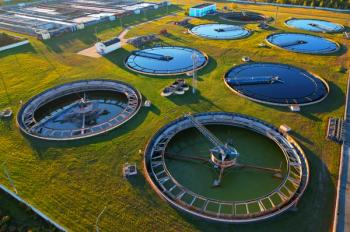
The LCGC Blog: MS Identification of Microorganisms in Groundwater Near Unconventional Oil and Gas Extraction
Two things were surprising about some recent research we reported. First, with regard to chemically impaired groundwater quality, it may not always be the chemicals that are most worrisome for human health impacts. Second, the primary methodology we used in that work for microorganism identification, matrix-assisted laser desorption–ionization mass spectrometry (MALDI-MS), is a vastly underappreciated tool, especially outside the clinical realm in areas such as environmental monitoring.
Two things were surprising about some recent research we reported. First, with regard to chemically impaired groundwater quality, it may not always be the chemicals that are most worrisome for human health impacts. Second, the primary methodology we used in that work for microorganism identification, matrix-assisted laser desorption–ionization mass spectrometry (MALDI-MS), is a vastly underappreciated tool, especially outside the clinical realm in areas such as environmental monitoring.
To close out 2017, we published three research articles highlighting our past year’s efforts to study microbial populations in groundwater in close proximity to unconventional oil and gas (UOG) extraction activities (1–3). We were particularly interested to understand whether groundwater, which harbored signatures of chemical contamination-even at levels below the maximum contamination limits (MCL) set by the United States Environmental Protection Agency (US EPA) for safe drinking water standards-might reveal abnormal levels of microbes, which were not being monitored. We felt it was plausible that groundwater affected by increased levels of organic constituents, such as natural gas, or total dissolved solids might help microbial populations in these waters proliferate.
Indeed, that is exactly what we found. In general, the more contaminated the water, the greater the number and diversity of microbes we found living there.
Many of the microbes we found included those that you might expect in any environmental sample. However, we also found some significant bad actors, like Pseudomonas aeruginosa, which is a bacterium short-listed by the World Health Organization as a priority pathogen for monitoring and control because of its high incidence of drug resistance. You do not want that organism in your drinking and bathing water. Actually, you do not want any microorganisms in your drinking water.
The US EPA safe drinking water standards include recommendations for testing of a few microorganisms, such as E. coli and coliform bacteria, but it is extremely limited. As I understand it, the justification for monitoring a short list of bacteria is that the detection of these could be indicative of a bigger problem. For example, coliform bacteria can be present if the water source has been contaminated with feces. Also, very simple and inexpensive test kits are available for these few targets. Importantly, the MCL set for these bacteria is zero colony forming units-that is, you are not supposed to have any of these bacteria in your drinking water. If you do, then you are supposed to stop using that source and have it treated through some type of disinfection process. In our case, most samples we tested contained a half dozen to more than a dozen different bacterial species. Again, many samples included species that are indeed considered harmful for human health. More importantly, some of the bacteria are known to be resistant to standard disinfection processes, such as chlorination.
Perhaps the biggest take-home message from these studies is that there are significant populations of microbes in water supplies used for human consumption that are not being monitored. Indeed, if your well water does not serve as a water supply for 25 or more people, the US EPA does not monitor it, and thus, many drinking water sources have likely never been tested for microbial (and chemical) contamination. We do not necessarily attribute UOG operations for the chemical contamination, which accompanied the microbial detects, but it is likely that anthropogenic processes, including agricultural activities, are creating water environments where bacteria can proliferate. In many of the cases we studied, the types and numbers of microbes present were more troublesome than the levels of chemicals detected. More work is needed in this area, from the standpoint of environmental monitoring, but also from the standpoint of novel means to remediate microbial contamination. Our efforts for 2018 will definitely move in these directions.
The findings of the research in terms of microbial detects were certainly the biggest outcome. However, for analytical chemists it is worthy to note that use of MALDI-MS in this context is also surprisingly underappreciated and underdeveloped.
Most analytical chemists appreciate the versatility of MALDI-MS for polymer, protein, and small-molecule analysis, especially for MS imaging. It is a straightforward technique where prepared samples are co-crystallized with an organic laser-absorbing matrix, so that analytes can be desorbed, ionized, and mass analyzed following laser ablation. It is a soft ionization technique, and for several years, MALDI-MS has been growing in popularity for use in microbial identification (4,5). Isolated and cultured microbes can be characterized based on their protein fingerprint, and identified based on the match of that fingerprint to a database.
Although thousands of organisms are present in the couple of commercially available databases, the databases have a strong clinical bias. There is certainly overlap in clinical and environmental organisms, but in the environment, it is becoming clear to us that the databases lack sufficient entries. For example, in one water sample, we might be able to culture and isolate 10–15 clearly different bacterial species, but perhaps half of these will generate a nice protein fingerprint that does not match anything in the database.
When we have presented this research at some microbiology conferences, it is clear, especially in the environmental realm, that biologists are not well aware that MALDI-MS exists or of its advantages for use in microbial identification. While the initial instrument purchase is expensive, the subsequent analysis is quite fast and less laborious than many traditional biochemical identification techniques. Of course, we still have to turn to RNA sequencing or other approaches as a means to confirm our MALDI-MS results or to identify those bacteria with no database match, but we are using these steps to further validate the MS approach and to expand the database for future monitoring efforts.
I could expound more on both the results of the study or the use of MALDI-MS, but it is not my intention here to go into great detail. That detail can be found in the cited publications. What is certain is that this is an interesting, underappreciated, and important research field for further study. Three years ago I would have had no idea that our group would be pursuing environmental microbial analysis, but now, it seems that 2018 will be quite heavily focused in this area. Stay tuned for more updates in the future. Happy New Year!
References
(1) I.C. Santos, M.S. Martin, M.L. Reyes, D.D. Carlton Jr., P. Stigler-Granados, M.A. Valerio, K.W. Whitworth, Z.L. Hildenbrand, and K.A. Schug, Sci. Tot. Environ.618, 165–173 (2018).
(2) M.S. Martin, I.C. Santos, D.D. Carlton Jr., P. Stigler-Granados, Z.L. Hildenbrand, and K.A. Schug, Sci. Tot. Environ, in press.
(3) I.C. Santos, M.S. Martin, D.D. Carlton Jr., C.L. Amorim, P.M.L. Castro, Z.L. Hildenbrand, and K.A. Schug, Microorganisms5, 47 (2017).
(4) I.C. Santos, Z.L. Hildenbrand, and K.A. Schug, Analyst141, 2827–2837 (2016).
(5) V. Havlicek, K. Lemr, K.A. Schug, Anal. Chem.85, 790–797 (2013).
Kevin A. Schug is a Full Professor and Shimadzu Distinguished Professor of Analytical Chemistry in the Department of Chemistry & Biochemistry at The University of Texas (UT) at Arlington. He joined the faculty at UT Arlington in 2005 after completing a Ph.D. in Chemistry at Virginia Tech under the direction of Prof. Harold M. McNair and a post-doctoral fellowship at the University of Vienna under Prof. Wolfgang Lindner. Research in the Schug group spans fundamental and applied areas of separation science and mass spectrometry. Schug was named the LCGC Emerging Leader in Chromatography in 2009 and the 2012 American Chemical Society Division of Analytical Chemistry Young Investigator in Separation Science. He is a fellow of both the U.T. Arlington and U.T. System-Wide Academies of Distinguished Teachers.
Newsletter
Join the global community of analytical scientists who trust LCGC for insights on the latest techniques, trends, and expert solutions in chromatography.





